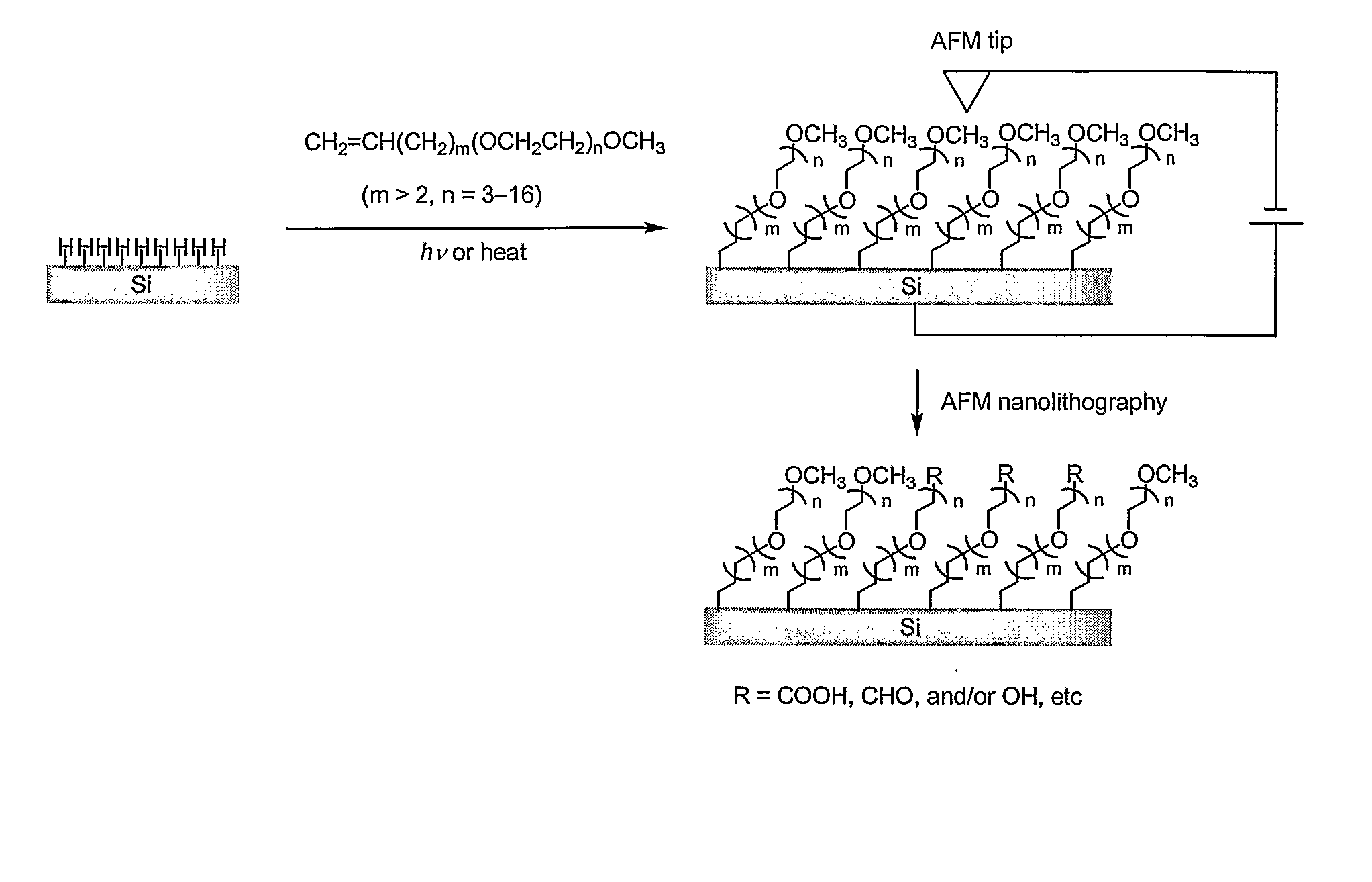Preparation of nanometric arrays of biomolecules on oligo- or poly(ethylene glycol) films on silicon surfaces
a biomolecule and nanometer technology, applied in the field of microarrays, can solve problems such as limiting the stability of biomolecules under physiological conditions
- Summary
- Abstract
- Description
- Claims
- Application Information
AI Technical Summary
Benefits of technology
Problems solved by technology
Method used
Image
Examples
example 1
[0038]This example serves to illustrate materials used in the fabrication of nanometric protein arrays, on protein-resistant monolayers on silicon surfaces, in accordance with embodiments of the present invention.
[0039]Pyridine, succinic anhydride, 4-dimethylaminopyridine (DMAP), 1-ethyl-3-(3-dimethylaminopropyl)-carbodiimide (EDAC), avidin, bovine serum albumin (BSA), biotinamidocaproyl labeled BSA (biotin-BSA), proteinase K, and phosphate buffered saline (PBS buffer, 0.01 M phosphate, 0.14 M NaCl, pH 7.4) were purchased and were used without purification.
example 2
[0040]This example serves to illustrate the synthesis of hepta(ethylene glycol) methyl ω-undecenyl ether (comprising EG7), as used in some embodiments of the present invention.
[0041]Monomethyl hepta(ethylene glycol) (1.637 g, 4.81 mmol) was slowly added to NaH (0.81 g, 33.75 mmol) in dry THF (8 ml) while stirring under N2. To this mixture was added Bu4NI (0.81 g, 0.48 mmol) and 11-bromo-1-undecene (4.2 ml, 16.78 mmol), and the mixture was refluxed for 20 hours under N2. Iodomethane (3.42 g, 24.1 mmol) was added, and the mixture was refluxed for 1 hour. The reaction mixture was then refluxed with methanol for another hour. After cooling to room temperature, the mixture was concentrated under reduced pressure. Dichloromethane was added, and the mixture was subsequently poured into water. The organic layer was separated, and the aqueous layer was extracted twice with dichloromethane. The combined organic layers were washed twice with water, dried with magnesium sulfate, filtered and co...
example 3
[0042]This example serves to illustrate photo-induced surface hydrosilylation, in accordance with embodiments of the present invention.
[0043]H-terminated silicon (100 or 111) surfaces were prepared using procedures similar to those described by Hines and Chidsey (Krämer et al., Chem. Rev. 2003, vol. 103, p. 4367). Briefly, single-sided polished silicon (100) or silicon (111) wafers with a resistivity less than 5 ohm·cm were cut into pieces of ca. 1×1 cm2, cleaned with NH4OH / H2O2 / H2O (v / v 1:1:4) at 80° C. for 20 minutes, thoroughly washed with Millipore-purified water, etched in 10% buffer-HF for 10 minutes and then in 40% NH4F for 10 minutes under N2 purge, and dried with a flow of nitrogen. The setup and procedures for photo-induced surface hydrosilylation of H-terminated silicon substrate surfaces with alkenes were described in detail elsewhere (Yam et al., Chem. Commun., 2004, p. 2510). Briefly, a freshly prepared H—Si (100) or H—Si (111) substrate was placed inside a freshly cle...
PUM
| Property | Measurement | Unit |
|---|---|---|
| size | aaaaa | aaaaa |
| sizes | aaaaa | aaaaa |
| size | aaaaa | aaaaa |
Abstract
Description
Claims
Application Information
 Login to View More
Login to View More - R&D
- Intellectual Property
- Life Sciences
- Materials
- Tech Scout
- Unparalleled Data Quality
- Higher Quality Content
- 60% Fewer Hallucinations
Browse by: Latest US Patents, China's latest patents, Technical Efficacy Thesaurus, Application Domain, Technology Topic, Popular Technical Reports.
© 2025 PatSnap. All rights reserved.Legal|Privacy policy|Modern Slavery Act Transparency Statement|Sitemap|About US| Contact US: help@patsnap.com



